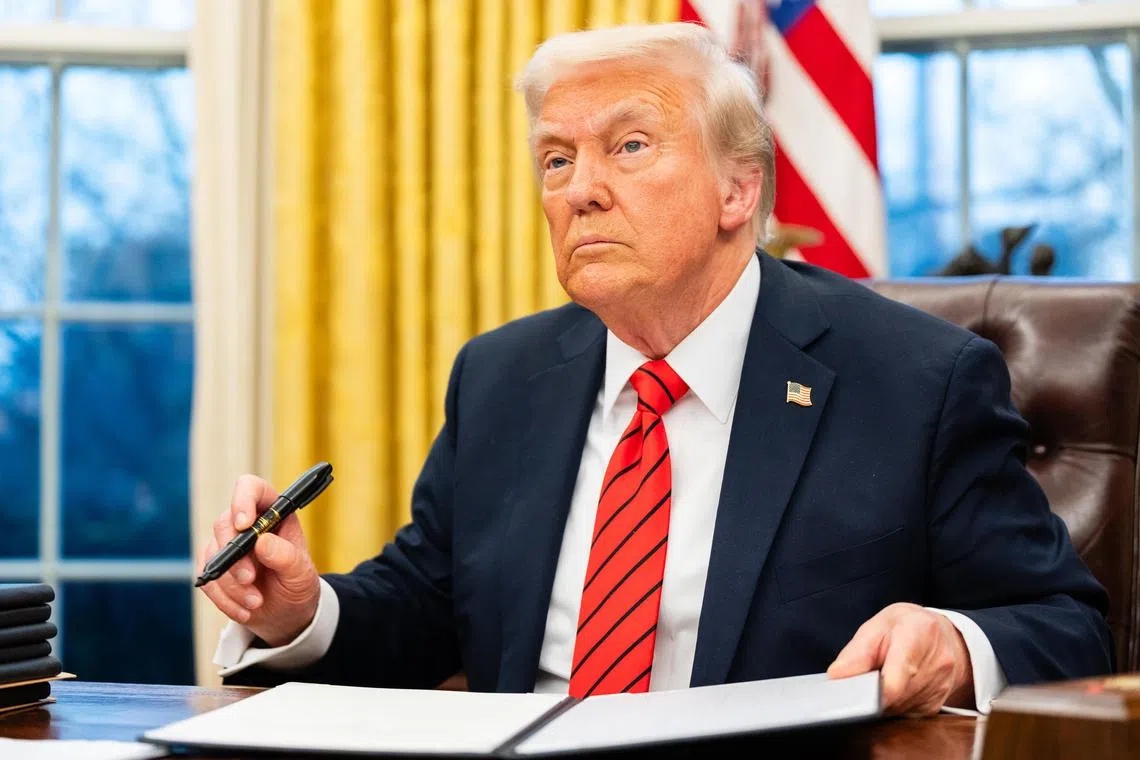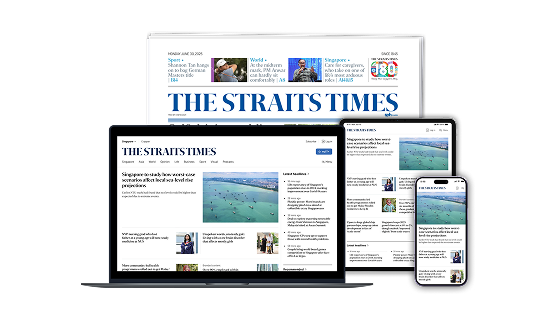Why Trump wants higher tariffs on steel and aluminium
Sign up now: Get ST's newsletters delivered to your inbox

US President Donald Trump on Feb 10 signing executive orders, including those imposing a 25 per cent tariff on imported steel and aluminium.
PHOTO: ERIC LEE/NYTIMES
Follow topic:
NEW YORK – As he tries to reshape US trade ties with the rest of the world, President Donald Trump has announced yet more tariffs: new 25 per cent levies on US imports of steel and aluminium,
While the move is aimed at strengthening domestic production, it carries implications for the wider economy, given that the US relies on imports to meet a large portion of demand for the metals in sectors such as construction, auto manufacturing, drinks packaging and the production of military equipment.
Mr Trump had already unveiled, then paused, blanket 25 per cent tariffs on imports from Canada and Mexico, then went ahead with new 10 per cent taxes on goods from China.
The latest plan revises a tariff regime introduced during the US President’s first administration, when steel and aluminium imports were subjected to new levies following years of complaints from American companies and labor unions about overseas competition.
What are the new tariffs Trump announced?
The US President said the tariffs would apply to “everybody” – meaning all nations. The levies will also cover finished metal products, a significant move that will have broad-reaching price impacts on US consumers.
Tariffs imposed during Mr Trump’s first presidential term focused mostly on basic steel and aluminium products, whereas the latest tariffs will include things like metal shapes and processed goods that are needed to build automobiles, window frames and skyscrapers among other things.
Why steel and aluminium?
During Mr Trump’s first successful presidential campaign a decade ago, he railed against the decline of US steel towns and aluminium hubs after decades of falling production and dwindling employment amid China’s rise as the world’s manufacturing superpower.
In 2018, during his first term in the White House, Mr Trump imposed tariffs of 25 per cent on steel imports and 1 per cent on aluminium imports. His aim was to boost US output by making foreign material more expensive for American buyers. Several major suppliers including Canada, Mexico and the European Union were ultimately exempted, however. Today, US industries say they are still struggling to compete with imports.
More broadly, trade frictions in the global steel and aluminium sectors have grown in the past year amid a renewed flood of products from China. That has prompted trade measures against Chinese imports from numerous places such as Vietnam, India and the European Union.
Which countries could be most affected by the metals tariffs?
US net imports make up more than four-fifths of the country’s aluminium requirement, and about 17 per cent of its steel needs, according to figures from Morgan Stanley.
Canada could bear the brunt of tariffs as the top supplier of both metals. It accounts for 58 per cent of US aluminium imports by volume, followed by 6 per cent from the United Arab Emirates, and 4 per cent from China, according to figures from the US government. For steel, Canada is again the biggest at 23 per cent, followed by Brazil at 16 per cent, Mexico at 12 per cent, then South Korea at 10 per cent.
What will happen next?
While Mr Trump has set out the plan in broad terms, his record in office – in his first term and so far in his second – suggests there is room for negotiation. Several exporting nations or regions ultimately won exemptions from the metals tariffs launched in Mr Trump’s first term, while some oil companies also won exclusions based on their need for special products.
This time, US officials said they were wary of granting any leeway but Mr Trump indicated that he may consider a break for Australia, crediting the country’s import of US-made aircraft.
Also, it is not clear how new steel and aluminium tariffs would relate to trade measures already in place. For example, it is not known whether the new metals tariffs would be added to other levies, for example, the new blanket 10 per cent tariff on all Chinese goods and an older 25 per cent tariff in place on Chinese steel.
Mr Trump has said he wants to impose tariffs on copper imports and that those would take a bit longer to implement than the ones on aluminium and steel.
Will the tariffs achieve their purpose?
When Mr Trump’s first administration unveiled tariffs on steel and aluminium, the goal was to make the US more self-sufficient in these metals. But in 2024, the output of the US steel industry was 1 per cent lower than it had been in 2017, before the first round of Trump tariffs, and the aluminium industry produced almost 10 per cent less.
Rising costs – especially for labour and energy – have been a major driver in the long-term decline of these US industries. Canada plays a vital role in supplying aluminium to the US because its plants often draw on cheap hydropower.
Economists warn that Mr Trump’s tariffs risk raising household expenses such as groceries and petrol – potentially stoking the very inflationary pressures he campaigned on quelling. Administration officials counter that the levies are part of a broader economic strategy – including extended tax cuts and expanded domestic energy production – that will help lower costs overall. BLOOMBERG

